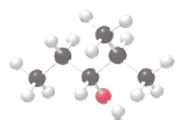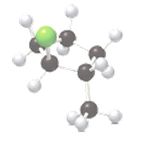
ALEKS 360 ACCESS CARD F/GEN. ORG.CHEM
3rd Edition
ISBN: 9781264452545
Author: SMITH
Publisher: MCG
expand_more
expand_more
format_list_bulleted
Question
Chapter 14, Problem 14.37P
Interpretation Introduction
(a)
Interpretation:
The name of the following molecule which is depicted in the ball-and-stick model should be determined.

Concept Introduction:
Name of the compound can be assigned according to below rule:
First, identify the number of carbon atoms present in the longest continuous chain, and then identify the
Interpretation Introduction
(b)
Interpretation:
The name of the following molecule which is depicted in the ball-and-stick model should be determined.

Concept Introduction:
Name of the compound can be assigned according to below rule:
First, identify the number of carbon atoms present in chain, and then identify the function group if present in the given compound.
Expert Solution & Answer
Want to see the full answer?
Check out a sample textbook solution
Students have asked these similar questions
Find a mole of :
H2SO4 (15 ml 3.0 M)
NaOH ( 18 mL 2.5 M)
Acetic anhydride (3.0 mL)
For the mechanism, show everything, lone paires, charges and arrow please
molecule
0=
OH
☐ ☐
type of molecule
(check all that apply)
fatty acid
monoglyceride
diglyceride
triglyceride
saturated
unsaturated
monounsaturated
☐ polyunsaturated
☐ ☐ ☐ ☐ ☐
010 0 0 0 0 0 0
☐ ☐ ☐ ☐☐☐☐
U
omega-3
omega-6
fatty acid
monoglyceride
diglyceride
triglyceride
saturated
unsaturated
monounsaturated
polyunsaturated
omega-3
omega-6
fatty acid
monoglyceride
diglyceride
triglyceride
saturated
unsaturated
monounsaturated
polyunsaturated
omega-3
omega-6
OH
OH
Chapter 14 Solutions
ALEKS 360 ACCESS CARD F/GEN. ORG.CHEM
Ch. 14.1 - Prob. 14.1PCh. 14.2 - Prob. 14.2PCh. 14.2 - Classify each hydroxyl group in sorbitol as 1°,...Ch. 14.2 - Prob. 14.4PCh. 14.2 - Prob. 14.5PCh. 14.3 - Prob. 14.6PCh. 14.3 - Give the structure corresponding to each name a....Ch. 14.5 - Draw the products formed when each alcohol is...Ch. 14.5 - Prob. 14.9PCh. 14.5 - Prob. 14.10P
Ch. 14.5 - Prob. 14.11PCh. 14.6 - Prob. 14.12PCh. 14.6 - Prob. 14.13PCh. 14.7 - Prob. 14.14PCh. 14.7 - Prob. 14.15PCh. 14.7 - Prob. 14.16PCh. 14.7 - Prob. 14.17PCh. 14.8 - (a) Translate the hall and stick model of...Ch. 14.8 - Prob. 14.19PCh. 14.9 - Prob. 14.20PCh. 14.9 - Prob. 14.21PCh. 14.9 - Prob. 14.22PCh. 14.9 - Prob. 14.23PCh. 14.9 - Prob. 14.24PCh. 14.9 - Prob. 14.25PCh. 14.10 - Prob. 14.26PCh. 14.10 - Prob. 14.27PCh. 14.10 - Prob. 14.28PCh. 14 - Prob. 14.29PCh. 14 - Prob. 14.30PCh. 14 - Prob. 14.31PCh. 14 - Classify each halide hi A as 1°, 2°, or 3°. A is a...Ch. 14 - Prob. 14.33PCh. 14 - Draw the structure of a molecule that fits each...Ch. 14 - Draw the structure of the six constitutional...Ch. 14 - Draw the structure of the four constitutional...Ch. 14 - Prob. 14.37PCh. 14 - Prob. 14.38PCh. 14 - Prob. 14.39PCh. 14 - Answer each question about alcohol B. Draw a...Ch. 14 - Prob. 14.41PCh. 14 - Give the IUAPC name for each alcohol.Ch. 14 - Prob. 14.43PCh. 14 - Prob. 14.44PCh. 14 - Prob. 14.45PCh. 14 - Prob. 14.46PCh. 14 - Draw the structures and give the IUPAC names for...Ch. 14 - Prob. 14.48PCh. 14 - Prob. 14.49PCh. 14 - Prob. 14.50PCh. 14 - Give the structure corresponding to each IUPAC...Ch. 14 - Give the structure corresponding to each IUPAC...Ch. 14 - Which compound in each pair has the higher boiling...Ch. 14 - Rank the compounds in order of increasing melting...Ch. 14 - Rank the following compounds in order of...Ch. 14 - Rank the following compounds in order of...Ch. 14 - Prob. 14.57PCh. 14 - Prob. 14.58PCh. 14 - Prob. 14.59PCh. 14 - Prob. 14.60PCh. 14 - Prob. 14.61PCh. 14 - Prob. 14.62PCh. 14 - Prob. 14.63PCh. 14 - Prob. 14.64PCh. 14 - Prob. 14.65PCh. 14 - Prob. 14.66PCh. 14 - Prob. 14.67PCh. 14 - Prob. 14.68PCh. 14 - Prob. 14.69PCh. 14 - Prob. 14.70PCh. 14 - Prob. 14.71PCh. 14 - Prob. 14.72PCh. 14 - Prob. 14.73PCh. 14 - Prob. 14.74PCh. 14 - Prob. 14.75PCh. 14 - Prob. 14.76PCh. 14 - Prob. 14.77PCh. 14 - Prob. 14.78PCh. 14 - Prob. 14.79PCh. 14 - Prob. 14.80PCh. 14 - Prob. 14.81PCh. 14 - Prob. 14.82PCh. 14 - Prob. 14.83PCh. 14 - Prob. 14.84PCh. 14 - Prob. 14.85PCh. 14 - Prob. 14.86PCh. 14 - With reference to the halogenated organic...Ch. 14 - Prob. 14.88PCh. 14 - Prob. 14.89PCh. 14 - Prob. 14.90PCh. 14 - Write out the chemical reaction that occurs when a...Ch. 14 - Prob. 14.92PCh. 14 - Prob. 14.93PCh. 14 - Lactic acid [CH3CH(OH)CO2H] gives sour milk its...Ch. 14 - Prob. 14.95PCh. 14 - Prob. 14.96PCh. 14 - Prob. 14.97PCh. 14 - Prob. 14.98PCh. 14 - Prob. 14.99PCh. 14 - Answer the following questions about alcohol B....Ch. 14 - Prob. 14.101CPCh. 14 - Dehydration of alcohol C forms two products of...
Knowledge Booster
Learn more about
Need a deep-dive on the concept behind this application? Look no further. Learn more about this topic, chemistry and related others by exploring similar questions and additional content below.Similar questions
- '☐ : ☑ ด Suppose an alien life form has DNA just like human DNA remain the same.) - except that the alien DNA is made from deoxyarabinose instead of deoxyribose. (All other ingredients Draw the structure of a nucleotide containing thymine from which the alien DNA would be assembled. Note: be sure to draw the molecule as it would exist at physiological pH. Click and drag to start drawing a structure.arrow_forwardPredict the products of the following biochemical reaction: CH2 CH-O + 3 KOH CH2-0 In particular, draw the structure of the product or products P in the drawing area below. If there are no products, because this reaction won't happen, check the No reaction box under the drawing area. Note: if there is more than one product, you can draw them in any arrangement you like. Also, just draw the structure of each product. You don't have to draw the complete right-hand side of the equation, including stoichiometric coefficients. No reaction Click and drag to start drawing a structure. : 5 èarrow_forwardAssign these spectrumarrow_forward
- If I have 30% H2O2, indicate how to prepare a 6% H2O2 solution.arrow_forward7) 8) FCI II -C-C-C=C-C || Br Br || -C=C-Br -CEC-C-C- 10) 11) F Br i OH مله 12) Br i 13) 14) 15) CH3CHFCHFC=CH C(OH)Br2CHF(CH2)4CH2CH3 CH3(CH2)3CH=CH(CH2)2CH3arrow_forwardName 1) 3-fluoro, 1-butene 2) 2-heptene 2,3-difluoro- 1-pentene 4) 6-iodo,4-methyl- 2-decyne 5) 4,4-dibromo- 1,2-butandiol Complete structural formula F -C=C-C-C- Line formula Condensed structural formula N F CH2=CHCHFCH3arrow_forward
- 1. Part 1: Naming Organic Compounds он H₁C-C-CH3 CH3 Br CI CI 2. Br-CH-CH-CH₂ H₂C-CH-C= -CH-CH2-CH3 3. HC-CH-CH-C-OH 5. H₂C-CH-CH₂-OH 7. OH 4. CH CH₂-CH₂ 6. сно CH-CH-CH-CH₂-CH₂ H₁₂C-CH-CH-CH-CH₁₂-CH₁₂ 8. OHarrow_forward11 Organic Chemistry Organic Nomenclature Practice Name/Functional Group n-butane Formula Structural Formula (1) C4tt10 H3C C- (2) CH3CH2CH2 CH 3 H₂ -CH3 Н2 name & functional group (1) and (2) OH H₁₂C Н2 name only (1) and (2) name only (1) and (2) H₁C - = - CH₂ Н2 HC=C-C CH3arrow_forwardUnder aqueous basic conditions, nitriles will react to form a neutral organic intermediate 1 that has an N atom in it first, and then they will continue to react to form the final product 2: NC H₂O он- H₂O 1 2 OH Draw the missing intermediate 1 and the final product 2 in the box below. You can draw the two structures in any arrangement you like. Click and drag to start drawing a structure.arrow_forward
- Assign these COSY Spectrumarrow_forwardAssign these C-NMR and H-NMR Spectrumarrow_forwardPredict the product of this organic reaction: IZ + HO i P+H₂O Specifically, in the drawing area below draw the skeletal ("line") structure of P. If there is no reasonable possibility for P, check the No answer box under the drawing area. No Answer Click and drag to start drawing a structure. ☐ :arrow_forward
arrow_back_ios
SEE MORE QUESTIONS
arrow_forward_ios
Recommended textbooks for you
 Introductory Chemistry: An Active Learning Approa...ChemistryISBN:9781305079250Author:Mark S. Cracolice, Ed PetersPublisher:Cengage Learning
Introductory Chemistry: An Active Learning Approa...ChemistryISBN:9781305079250Author:Mark S. Cracolice, Ed PetersPublisher:Cengage Learning Chemistry: Principles and PracticeChemistryISBN:9780534420123Author:Daniel L. Reger, Scott R. Goode, David W. Ball, Edward MercerPublisher:Cengage Learning
Chemistry: Principles and PracticeChemistryISBN:9780534420123Author:Daniel L. Reger, Scott R. Goode, David W. Ball, Edward MercerPublisher:Cengage Learning Chemistry for Today: General, Organic, and Bioche...ChemistryISBN:9781305960060Author:Spencer L. Seager, Michael R. Slabaugh, Maren S. HansenPublisher:Cengage Learning
Chemistry for Today: General, Organic, and Bioche...ChemistryISBN:9781305960060Author:Spencer L. Seager, Michael R. Slabaugh, Maren S. HansenPublisher:Cengage Learning

Introductory Chemistry: An Active Learning Approa...
Chemistry
ISBN:9781305079250
Author:Mark S. Cracolice, Ed Peters
Publisher:Cengage Learning

Chemistry: Principles and Practice
Chemistry
ISBN:9780534420123
Author:Daniel L. Reger, Scott R. Goode, David W. Ball, Edward Mercer
Publisher:Cengage Learning

Chemistry for Today: General, Organic, and Bioche...
Chemistry
ISBN:9781305960060
Author:Spencer L. Seager, Michael R. Slabaugh, Maren S. Hansen
Publisher:Cengage Learning

07 Physical Properties of Organic Compounds; Author: Mindset;https://www.youtube.com/watch?v=UjlSgwq4w6U;License: Standard YouTube License, CC-BY